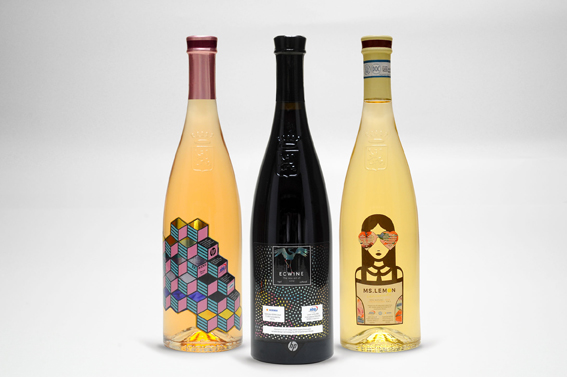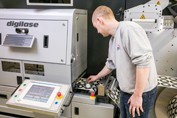AB Graphic International selects HERMA self-adhesive materials for label sample book
New laser die cutting system delivers sharp outlines
- Using HERMA self-adhesive materials and HP printing technology, AB Graphic International has produced a new sample catalogue containing abstract and highly complex label shapes.
- Catalogue prompted by market launch of redesigned laser die cutting system Digilase S3.
- Uniform adhesive application predestines HERMA label stock for conversion by laser die cutting.
In producing the new high-quality samples, AB Graphic International highlights the level of sophistication made possible in the label segment by laser die cutting systems, from well-defined shapes and detailed outlines to the neat removal of cutting waste. To achieve these properties, the world's leading specialist in digital finishing equipment has placed its faith in HP Indigo printing technology and HERMA self-adhesive materials. The sample book marks the launch by AB Graphic International of the completely redesigned laser die cutting system Digilase S3. "The redesign gives label producers and users fresh scope to create innovative label formats," says Floriana Montella, Business Development Manager of AB Graphic International. "Our new samples clearly demonstrates how unusual labels with striking special effects and eye catching elements can be used as effective marketing tools. HP and HERMA were the ideal partners to help us create and produce these outstanding sample labels."

No discernible transverse section
To make best possible use of the scope afforded by the new Digilase S3, selecting an appropriate adhesive material is very important – in particular as regards uniform adhesive application. Fluctuations of around plus/minus 3 grams per square metre are not at all unusual, which can give rise to variances of as much as 15 percent with the quantities of adhesive that are generally applied. For laser die cutting especially, such inconsistencies can trigger unsatisfactory results when removing the cutting waste. As Dr. Ulli Nägele, HERMA's head of development, explains, "Special curtain coating enables us to apply extremely consistent coats. A discernible transverse section, consisting of peaks and valleys of adhesive, no longer exists." Even for standard adhesives, HERMA guarantees application tolerances of just plus/minus 1.5 grams per square metre. "We have been collaborating with HERMA for many years,” continues Floriana, “and use its adhesive materials when running tests with new machines. We have every confidence in the quality of the materials for our purposes." The labels for the sample book were designed and printed on rolls by experts at HP Indigo in Barcelona before being produced for the sample book by contactless laser die cutting. “HERMA’s premium variety of self-adhesive materials we used delivered outstanding results with our HP Indigo ElectroInks printed on the HP Indigo 8000 Digital Press and the HP Indigo WS6800 Digital Press," confirms Teresa Baena, Pre Sales Technical Consultant for HP Indigo Labels & Packaging at the HP Experience Center Barcelona.
Optimised cutting performance
The redesigned Digilase S3 is characterised by supreme precision, job changeover on the fly, and outstanding efficiency. "The laser heads have been replaced with a new type in order to enhance cutting performance and suit the widest range of substrates," explains Floriana Montella. "With the Digilase S3, the only consumables you need to change are the filters of the fume extraction system; you don’t have to periodically refill the laser gas."
Unlike a physical die-cutter, which exerts pressure on and displaces the adhesive until a defined stop point is reached, the laser generates an exactly metered amount of energy. In other words, the laser does not cut, but blasts away or literally pulverises the material. In ideal circumstances the laser delivers the exact amount of energy required to blast away both the substrate and the adhesive layer without damaging the liner. In view of the high precision that is generally applied in the production of the liner paper and label material, as little variation as possible in the adhesive is crucial.






